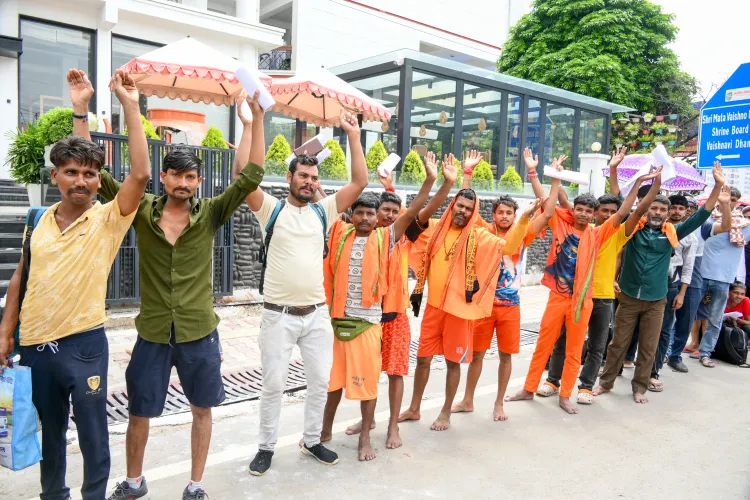Is the Unabated Rush of Devotees Continuing as Over 3.31 Lakh Perform Amarnath Yatra in 20 Days?

Synopsis
Key Takeaways
- 3.31 lakh devotees have participated in the Yatra.
- The pilgrimage began on July 3 and ends on August 9.
- Security measures include over 8,000 special commandos.
- Devotees can choose between Pahalgam and Baltal routes.
- The cave shrine symbolizes the mythical powers of Lord Shiva.
Srinagar, July 23 (NationPress) The number of devotees participating in the Amarnath Yatra has surpassed 3.31 lakh within just 20 days, with the influx of pilgrims remaining strong as of Wednesday.
According to officials, since the commencement on July 3, over 3.31 lakh yatris have experienced ‘darshan’ at the sacred cave shrine.
“A new group of 2,837 yatris departed from Jammu city in two protected convoys consisting of 118 vehicles. The first convoy, with 49 vehicles carrying 1,036 pilgrims, set off at 3:25 a.m. for the Baltal base camp. The second convoy, which included 69 vehicles transporting 1,801 yatris to the Pahalgam base camp, left at 3:58 a.m.,” officials reported.
The continuous stream of yatris is evident as more pilgrims are arriving independently rather than in escorted groups. Pilgrims opting for direct arrival complete on-the-spot registration to access the cave shrine.
The Bhumi Pujan for ‘Chhari Mubarak’ (Lord Shiva’s Holy) was conducted at Pahalgam on July 10.
A group of seers, under the guidance of the sole custodian of the Chhari Mubarak, Mahant Swami Deependra Giri, transported it from its base at the Dashnami Akhara Building in Srinagar to Pahalgam.
Upon arriving in Pahalgam, the Chhari Mubarak was taken to the Gauri Shankar temple, where the Bhumi Pujan took place. After this, the Chhari Mubarak returned to its original location at the Dashnami Akhara building. Its final journey towards the cave shrine is scheduled to start from the Dashnami Akhara temple in Srinagar on August 4, reaching the holy cave shrine on August 9, which will mark the official end of the Yatra.
This year, the yatra is being conducted under stringent multi-layered security measures, especially after the tragic incident on April 22, where terrorists backed by Pakistan killed 26 civilians after separating them based on religion in the Baisaran meadow of Pahalgam.
An additional 180 companies of Central Armed Police Forces (CAPFs) have been deployed to bolster the existing contingents of the Army, BSF, CRPF, SSB, and local police. The Army has dispatched over 8,000 special commandos to ensure the safety of pilgrims this year.
The yatra, which began on July 3, will conclude after 38 days on August 9, coinciding with Shravan Purnima and Raksha Bandhan.
Devotees reach the holy cave shrine, located 3,888 metres above sea level in the Kashmir Himalayas, via either the traditional Pahalgam route or the shorter Baltal route.
Those taking the Pahalgam route journey through Chandanwari, Sheshnag, and Panchtarni to reach the cave shrine, covering a distance of 46 km on foot, which typically takes four days. Conversely, those using the shorter Baltal route trek 14 km to reach the shrine and return to the base camp the same day after having darshan.
Due to security concerns, no helicopter services are available for yatris this year.
The cave shrine features an ice stalagmite structure that fluctuates with the lunar phases. Devotees hold that this ice stalagmite represents the mythical powers of Lord Shiva.







